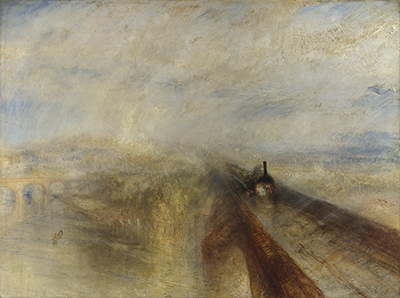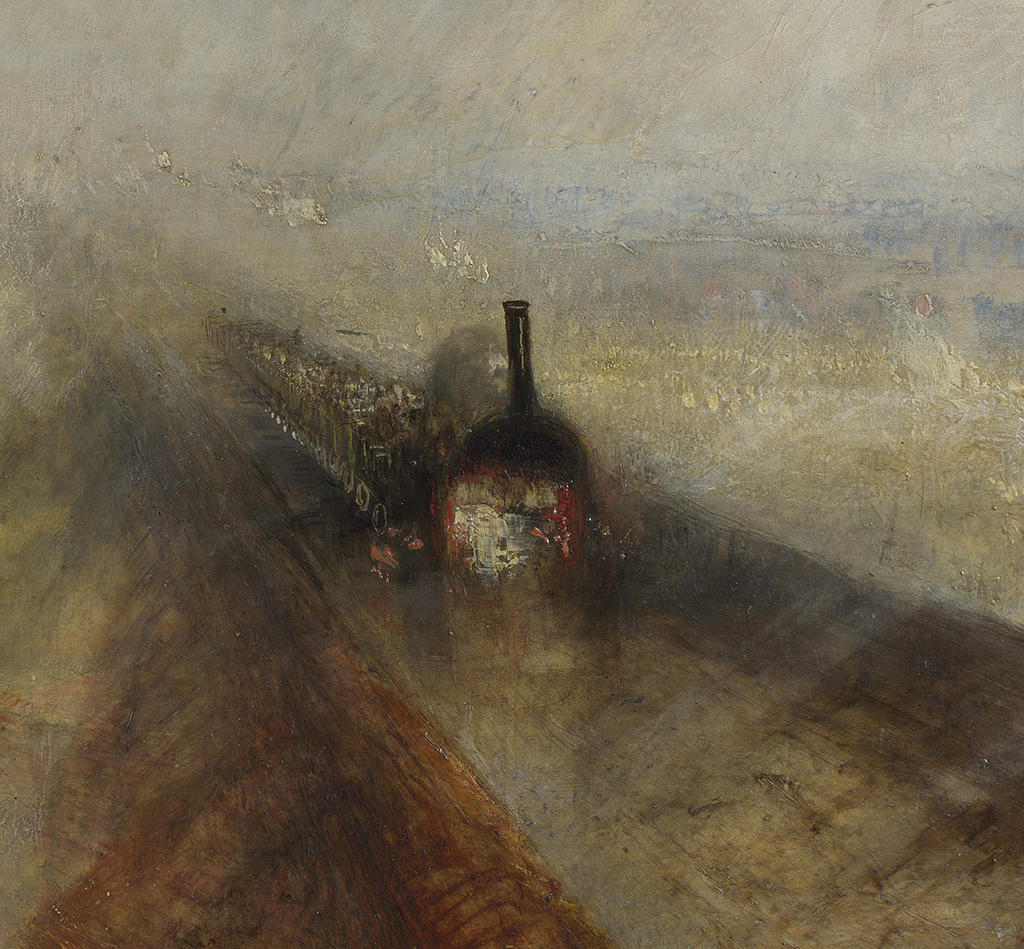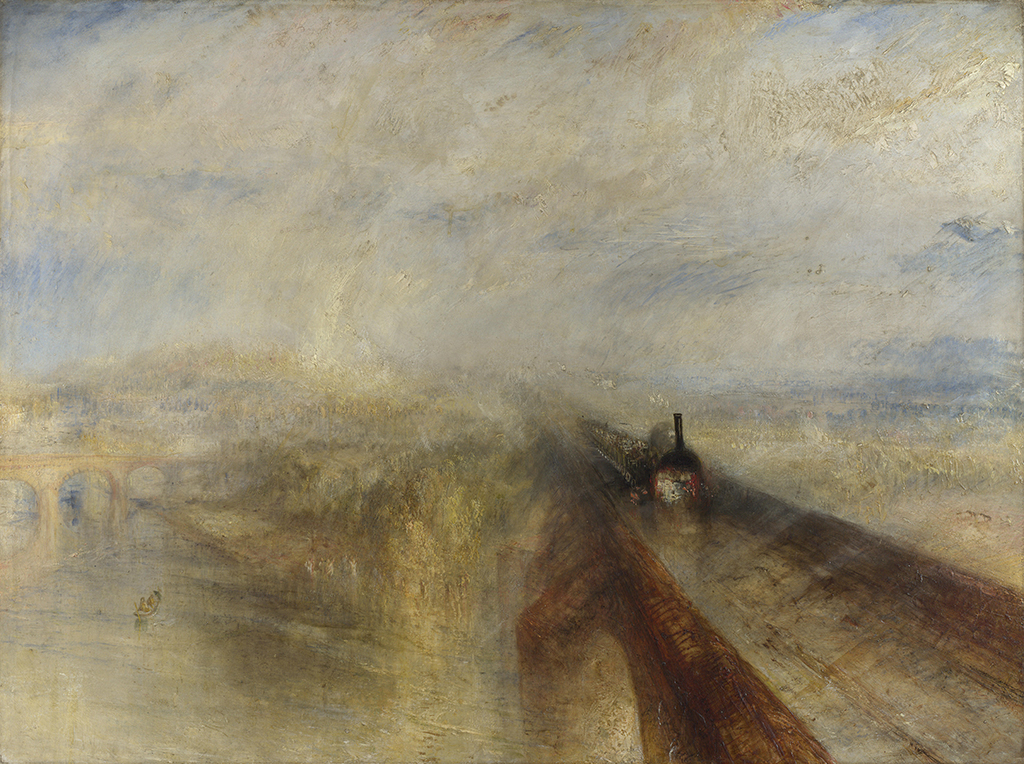Rain, Steam and Speed – The Great Western Railway is a painting by the famous British painter JMW Turner. It was painted in the mid-nineteenth century and it was first exhibited in the Royal Academy in 1844.
JMW Turner was famous for his use of swirling colours and for the dynamic nature of his work. This is definitely true of this painting, where swirls of steam and a rushing sky help to convey the impression of a train in dynamic motion. Rain Steam Speed depicts the Great Western Railway, which, after the innovations of the Bristolian engineer Kingdom Brunel, was one of the most lauded developments of the industrial age in Britain. The Great Western Railway is, in fact, still in existence in the UK though trains have now been modernised and no longer use steam, and the name has been shortened to GWR.
In Rain Steam Speed, we can see echoes of other works by Turner, such as his depictions of storms at sea. The painting Snow Storm, for example, which he painted over 20 years earlier in 1822-3 depicts a steam boat caught in a storm out to sea. Again, we see the twin themes of nature's power and human industry that are also at work in Rain Steam Speed.
The dramatic sea spray and waves surrounding the boat in Snow Storm might be compared to the dramatic steam and rain surrounding the train in Great Western Railway. One interesting thing about Great Western Railway, though, is the way in which the steam and the rain become blended and indistinguishable. We cannot see which vapour is produced by the train and which is produced by nature itself. The beauty is equivalent to his other masterpiece, The Fighting Temeraire.
This is helped by Turner's characteristic way of working with oils: he is well known for swirling and blending colours together to create a unified, bold look. Perhaps, here this is something that goes beyond a mere stylistic aspect of Turner's work, however, Perhaps, by blending steam and rain in this way, Turner is commenting on the way in which human engineering can become one with nature - it can add to its power and its strength. Industrial Britain was an exciting period in this nation's history, though not all artists were suporters of some of the developments - with some handcrafts being replaced by machined parts, individual creativity and the quality of hand produced pieces would start to disappear from many markets. These included the likes of Morris who set up several companies during his lifetime that sought to continue the attention to quality over cost within wallpaper and furniture.
In the scene we can spot a steam engine making it's way, at speed, across a new bridge by the Thames in Maidenhead. It was constructed under the direction of Brunel, one of the most significant Victorian engineers and a name that is linked closely to this period of British development. An interesting addition to the painting, and something that many might miss when viewing it for the first time, is that there is a hare in the nearest foreground that attempts to outrun the train. This is clearly a symbolic gesture by the artist, but there are several explanations as to just what exactly is the point that he is making. Perhaps it is the futility of nature to attempt to compete with the innovations and progressions of modern society, or perhaps it simply compares this stunning piece of engineering with the natural beauty found within the natural world. Either way, it certainly causes us to pause and consider this element of the composition.
"...The world has never seen anything like this picture..."
William Makepeace (novelist)
The dreamy style of Turner makes it particularly difficult to confidently identify parts of this painting, but we can be reasonably confident that the figures close to the rail line are bathers, catching a moment of fun as this impressive train comes driving past. They appear to be waving it on, it amazement at the ingenuity of man which was a common belief during this period of great change within the British industrial age. Many could not believe the pace at which things were changing, with machines taking up more and more roles within society that had previously been completed by hand. It brought and wealth and pride to the nation that had rarely been seen before, even with the sprawling influence of the existing empire. Rain, Steam and Speed – The Great Western Railway thus captures a snapshot of this entire era, with man, machine and nature all included alongside each other in a sort of live comparison. With figures waving the steam engine past, it is as if humanity's achievements had now gone beyond their own control and power.
The blurred nature of the train, coupled with the puffs of smoke that appear just above it, helps to give us an impression of great speed. This is not an easy thing to achieve within a static painting, but Turner accomplishes it with ease here. A closer inspection of the painting reveals a great amount of detail to the train than you might initially notice, but it is still relatively simple. This is typical of the Romanticist style, where the mind and imagination are given as much consideration as the reality. During this period of art we were essentially on a path towards abstraction, where form would become less and less obvious as the decades and centuries past. Many appreciated this art movement because of the balance it struck between form being identifiable, but also far from a realist depiction.
There is some ambiguity over just when exactly the artist executed this painting, but we do know for sure that it was first put on display in 1844. This led to that year being attributed to it, as it's date of creation, but that may not be entirely correct. The scene would have been on the Thames, around the town of Taplow. Many of the elements in this painting are still present today, partly due to the fact that this location is a good distance from London and therefore less frequently subjected to architectural and transportational changes. Instead, it is a stunning location that retains much of its charm and history, lying a commutable distance from the metropolis of London. Many of the achievements of Isambard Kingdom Brunel (Great Western Railway's chief engineer) remain very much intact because of his ability to build structures that would stand the test of time, as well as the lack of investment and fresh structures undertaken by the British Government, with regards the train infrastructure, over the past few decades.
In order to put this painting's timing in context with the overall British Industrialisation, it came around 1844, whilst the bridge itself was completed in 1838/39. This explains just how fresh in the public's mind this development was, and also the importance of Turner's comparison at that time, between engineering developments and the increasing threat to the natural world. When we consider these issues, it is fair to say that not an awful lot has changed since then and today, just with perhaps these issues becoming more of a global problem rather than being restricted to a few advanced nations as they were then. As mentioned earlier in this article, there were voices who spoke out against these developments, such as artists like William Morris, but the money to be earned from replacing the human touch with automated machinery was too big to ignore, particularly for the Government, businessmen and also the people who could work in these burgeoning industries.
"...Whether Turner's pictures are dazzling unrealities, or whether they are realities seized upon at a moment's glance, we leave his detractors and admirers to settle between them..."
The Times (1844)
In order to help you understand more about the painting, we have included several larger resolution photos of it below. One focuses purely on the steam engine itself, whilst the other captures the entire artwork as a whole. The painting remains a part of the world-respected collection of the National Gallery in London and is considered one of their most significant pieces, particularly with regards its importance to British history. Turner himself is regarded by many to have been the finest British artist of all time and many of his best paintings can be found in this impressive institution, including also the likes of The Fighting Temeraire, Calais Pier, Dido building Carthage and Ulysses deriding Polyphemus - Homer's Odyssey. Despite the years that have passed since his career took hold, he still remains much loved both in his native UK but also with many across the pond in the United States. Turner's impact on European art has also helped his reputation to impact art followers in mainland Europe too. The artist bequethed Rain, Steam and Speed – The Great Western Railway to the nation in 1856, a few years after his passing.
There are several different versions of this painting displayed online, some photos being more faithful than others. The images found here are inline with the artwork's owners. You can also see the video above which displays the original in front of your own eyes. One positive from this variation of photographs of the original is that some others have allowed us to see some elements of the scene more clearly. For example, the brick bridge in Maidenhead, over which the steam train passes at pace, is actually harder to see in the original painting than in some reproductions that have occurred online. Perhaps some have amended the scene in software packages in order to suit their own tastes, but it is clearly always important to display imagery which is faithful to the artist's original work, and this is something that we constantly strive for. The current host of the painting, The National Gallery, also offer an excellent insight into their painting, with a mixture of textual content and video presentations available, that dicuss this piece specifically.
The larger image above helps us to drill down further into some of the finer detail of this painting. There is a small boat, for example, making its way towards the lighter-toned bridge in the distance. It appears angled towards the bank, suggesting a fairly leisurely journey for this vessel. It will, no doubt, straighten up as it approaches the bridge ahead. Beyond that we can make out a small hill, perhaps a small town in the distance. The extra elements of interest, such as the small boat, are clearly added afterwards, with slightly darker tone of colour that enables the eye to make them out from the blurred, romantic mirage that exists within most of the painting. This style of romanticism rather than realism would divide critics during Turner's lifetime, with his reputation constantly falling in and out of favour. His bullish personality also did not particularly help him to make friends within the art world, but most just saw the beauty in his work and cared little about anything else.






